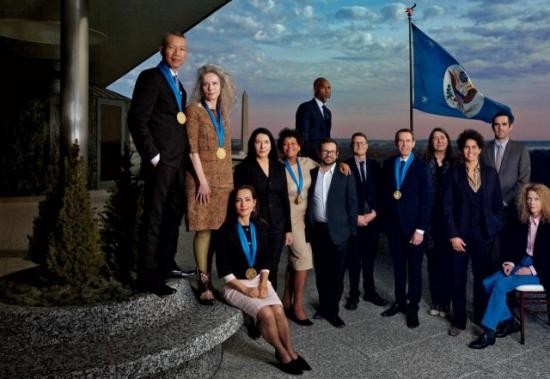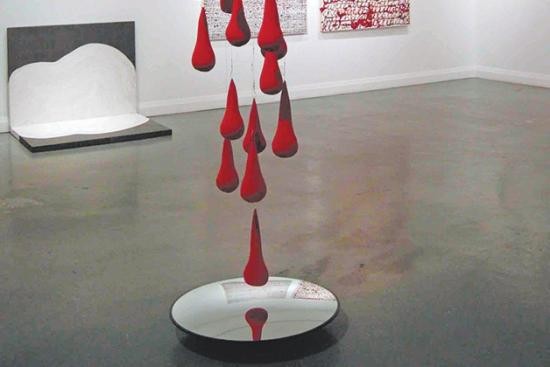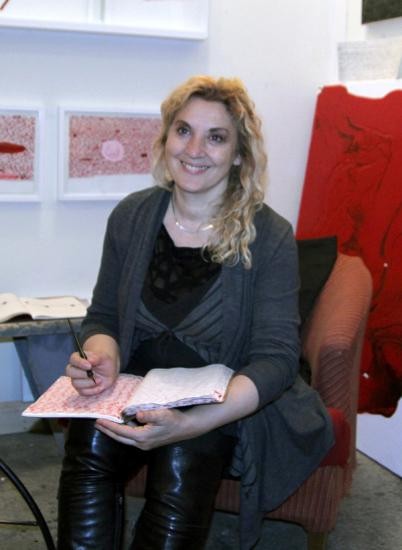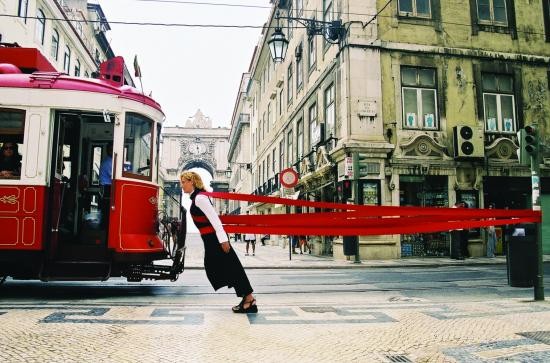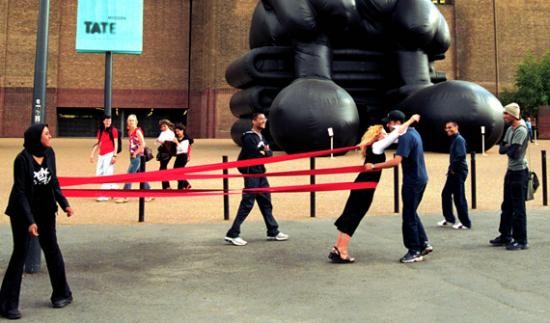Gareth Bate and Dawne Rudman, World of Threads Festival
Biography
Vessna Perunovich has established herself as one of Canada’s most compelling and adroit artists. With a fluidity and adept facility, her practice encompasses drawing, performance, video, sculpture, painting and installation. Individual, yet nonetheless inter-related, these aspects combine into an ever-evolving oeuvre that defies a simple categorization.
Consistently Perunovich’s subject matter grapples with issues of personal intimacy and of societal constructs. Her work is autobiographical and at the same time universal. It dwells emotionally and philosophically on the subject of boundaries, both physical and psychic, orchestrating a fine balance between confinement and content. Her art objects do not necessarily denote meanings. They are connotations of meanings, suggesting that they can wear the conceptual clothing necessary to expressing inexpressible feelings for things that are inexplicable.
A Toronto-based visual artist, Perunovich has exhibited at international biennales in Cuba, Albania, England, Portugal, Yugoslavia and Greece. She has attended international residencies in Berlin, Bursa, and Banff and will join an ISCP residency in New York in 2012. Her interdisciplinary survey exhibition has recently toured at prestigious public galleries and museums across Canada and in Europe. Perunovich is an artistic director of a multimedia Festival [FAT] Fashion Art Toronto. She is a recipient of T.F.V.A. (Toronto Friends of Visual Arts) award in 2005 and a Chalmers Development Grant in 2011 among many others.
Tell us about your work?
In my art practice I work with issues around displacement, exile, the notion of mobility and transience. My work explores the interdisciplinary format that comprises drawing, sculpture, video and performance. My diverse artistic interests are regularly manifested within an installation context that is site-specific and addresses the architectural and aesthetic parameters of the exhibiting space, in a manner in which it can evoke and convey the main concerns in my work. Those concerns are primarily humanist and political in nature. In my work, I constantly weave multiple narratives of my own experience, interconnecting it with the larger political and social forces in the world.
My work is experimental in its approach, minimalist in its esthetics, economical in material use and labour intensive in its process. In my work I use techniques that make reference to female labour and handicrafts such as sewing, knitting and crocheting and materials such as thread, string and fabric which were historically designed as 'female' signaling an inversion of the traditional perception of 'high art' versus craft. The politics is sewn into the work as they are often monumental in size and subject matter (politics, critiques of consumerism, violence, religion, sexuality, etc.) and in that it departs from the old (but still present) perceptions that the art made by women is intimate in nature and modest in size. The play between hard and soft surfaces serve as a constant reminder of the fragility of the body, and its struggle to move beyond barriers imposed by different spaces, institutions, ideologies, or its own failures.
My overall artistic practice continuously explores the theme of boundaries and limitations enacted through building structures that imply entrapment and engage with the notion of mobility. The work also plays with the margin and the center, by often positioning the audiences interactively inside of the work. The visceral response to the physicality of these installations is something that ultimately marries the intimate and the public, the personal and the political, in my work.
From where do you get your inspiration?
I am profoundly inspired by the opposing dynamics inherent in human behaviour: our dreams, aspirations, conflicts, as well as limitations. I am deeply interested in how we, as people, exist in the world, in all areas of our human interaction; politics, gender, cultural and social dynamics. My work is largely autobiographical and it draws inspiration from my own experiences, my childhood, intimate relationships, family life, the experience of immigration and departure from my homeland of ex-Yugoslavia in the late 80s, my travels and the encounters of different cultures.
Materials in general are another very important inspiration in my work. Since I was a child, I was interested in fabric and clothes as a way of expressing myself. I am drawn to fabric mostly because of its ability to convey emotion and adopt human qualities. I often start my creative process from being engaged with the energy of a certain material, its esthetics, texture or colour. Elastic materials in particular, stretchy fabrics, threads, strings and ribbon that carry with them the inherent quality of being “stretched”, fascinate me. The use of elastic materials in my work, allows me to express the ideas around the ability to transform qualities such as flexibility, adaptability and resilience in human nature.
What do you think of us placing your work within the context of fibre art?
When I look at my overall artistic practice, it makes a lot of sense to be placed within the context of fibre art. Both materials and processes related to fibre art have been a constant in my work since the late 90s. Although some mediums that I work with don’t necessarily employ fibre materials or processes, they often tie in with fibre art conceptually. For example my videos, installations and performances are usually conceptualized around the physical qualities of fabric and thread, or the act of stitching and weaving. In my drawings, I use continuous lines of ink (Fencescape, 2008) or graphite (Homage to Mother, 2010), to create labour-intensive woven-like imagery of nets and fences, which directly reference processes such as knitting, crocheting and weaving.
How do fibre techniques and materials relate to your practice?
Since very early on, I remember being interested in fabric and garments and having an emotional response to those materials. I grew up in Serbia and as a child, women in our family who were doing handicrafts always surrounded me. My mother and grandmother were doing knitting, crocheting, embroidering, weaving and knitting. Women being involved with clothing and handicrafts were heavily imbedded in the Serbian society’s traditional gender roles. My current work reflects on these traditional handicrafts as practiced in my family. It draws the parallel between the memories of my mother’s and grandmothers craftwork and my own drawings with line, as a way of “stitching together” the division between traditional and fine arts, as practiced respectively by three successive generations of Serbian women.
How did you decide on this medium?
In Belgrade, Serbia, I enrolled in the Academy of Fine Arts to study painting, obtaining a Masters Degree in 1987. I immigrated to Canada the following year. In the early nineties I was mostly painting in the style of surrealism. After a decade of painting, I found myself unable to express what I was feeling through painting and became disengaged with the medium.
I started experimenting with found objects and stretchy undergarments in the late 90s. I was surprised to discover that those new materials in my art practice felt so familiar and appropriate to express my concerns at the time. I began decomposing female undergarments and creating a body of work which commented on intimate relationships, sexuality, gender barriers and everyday life pressures. The series of work Intimacy & Beyond, Home Project, and Passion and Rage, created from 1997 to 2000 were mostly sculptural, combining a wide variety of found objects such as calipers, knives, projectiles, crutches, utensils, pins, plates and discarded furniture on one hand, and female undergarments such as pantyhose, tights and nylons on the other. To construct this work, I used simple techniques of cutting and decomposing the existing undergarments and reconstructing them in new ways. I used tension as a way of integrating the two materials together. By combining those contrasting materials, I tried to express the tension in intimate relationships, and opposing qualities like pleasure and pain, comfort and violence.
I think that I reconnected with my passion for fabric and the memory of my mother and grandmother’s practice in a certain moment in my lifetime when I felt most vulnerable and disconnected. I believe that introducing those materials in my work was a way of regenerating and re-inventing myself. It was a way of putting down my roots in a new country.
From 2000 onwards, I moved my attention from the intimate issues usually explored in my work, to more political and social subjects. This shift happened as I was starting to introduce performance into my art practice. My performance I Hug the World and the World Hugs Me Back from 2003 in which I offer a hug to passers by, proved to be instrumental for the shift of interest that took place. As the world in 2003 was becoming more polarized and global politics more divisive, I became passionately involved in the theme of physical barriers, such as fences and walls. I started using elastic bands, thread and string as a way of reflecting on the concept of barriers and borders. The materials I was using suggested flexible and transitory structures and challenged the solidity of walls / fences, rendering them permeable.
What other mediums do you work in, and how does this inform your work?
The work that I have created in the last fifteen years ties together as one interconnected body of work, where there is an ongoing dialog between pieces that were created over that period of time.
I work in drawing, painting, installation, video and performance and recently I also started to use sound in my work. I was trained as a painter, but practiced all of these other mediums more extensively than painting. The fact that I didn’t have any formal training in these other fields worked largely to my benefit. I think that because I wasn’t burdened by formal knowledge in these new disciplines, I didn’t feel obligated to do things in a certain way, and was allowed to maneuver in any way I saw fit. My general strategy, metaphorically speaking, is to go to this big “pool” of options and simply use the medium, which is best suited to express a particular idea. I learned more about how to use each particular medium as I went along. Because I am very easily bored with doing the same type of work all the time, this way of operating works best for me. It keeps me engaged and energized, generating new ideas in a more organic and less predictable way, and keeping the work playful and surprising.
Another strategy that I often apply to my art practice is re-using parts or elements of a previous work, almost as a way of recycling, and incorporating them in an entirely new way into a succeeding work. A good example of that is a net crafted out of thousands of elastic bands stitched together with staples. The net exists as an individual piece as well as an element in other works. It was originally created during my Berlin residency in 2009, for the performance piece Veiling-Unveiling. In the performance and a subsequent video work, I used the net to wrap and unravel my entire head in a continuous action. The same net became a sculptural installation constructed around the stairwell space of the residency, in the work entitled Spiral Descent, 2009. Lastly, it was incorporated as part of the multimedia installation entitled Open Ended in 2010, where it was stretched around a steal frame, transforming itself into a more rigid fence-like structure.
What specific historic artists have influenced your work?
I admire Renaissance masters like Leonardo Da Vinci and Piero della Francesca. There is something timeless and truly modern in their art that touches a cord with me. There is a real humility in their approach and a certain vulnerability, in spite of the grandeur of their subject matter. I was struck by Francisco de Goya’s etchings ‘Caprichos” and aquatint prints “Disaster of War” for their sharp satirical wit and his sense for the dramatic and theatrical. As an art student, I was influenced by Matisse’s collages, for the ingenious simplicity and his colour sensibility. I enjoy Fauvist painters Russo and Gauguin, for their rich imagination and their appetite for the exotic. I admire the inventiveness and humour of Picasso’s sculptural work and his immense talent for drawing and Romanian-born, French sculptor Constantin Brancusi for his exquisite elegance. Marcel Duchamp’s ready-mades and the conceptual approach to art making inherent in these works, forever changed our perspective on what art can be.
What specific contemporary artists have influenced your work?
The contemporary artists that have influenced my work include British artist David Hockney and his continuously fresh approach to the drawing medium; American sculptor Claus Oldenburg, his soft sculptures and his optimism and humour; Romanian born, French land artist Christo for creating magic with his “Surrounding Islands”, “Running Fence” and “Wrapped Reichstag” building; Israeli born, British installation/performance artist Mona Hatoum, for her political intelligence and her minimal esthetics; British sculptor Anish Kapoor for his use of red, his incredible ambition and his acute sensibility; Columbian installation artist Doris Salcedo, especially for her work “Shibboleth”, a big crack carved into the ground of the Turbine Hall at Tate Modern and for tackling issues like racism and colonialism; German/American artist Eva Hesse for her installations with thread and her smaller experimental works, for introducing fragility into the art esthetics; French / American artist Louise Bourgeois for her strangeness and ability to express personal narratives and sadness so powerfully, especially in “Cells”; Serbian performance artist Marina Abramović for her early work in ritual, gesture and experimentation with body limits; Italian artist Mauricio Catalan and his quirky dark humour and ability to surprise; American installation artist Ann Hamilton for her use of materials to transcend meaning; Israeli video artist Michael Rovner for her thoughtful, ingenious and beautifully haunting work on human condition, identity and patterns; Albanian video artist Anri Sala for his poetry and economy of means and Canadian video artist Mark Lewis for his slow and precise camera movement and his enchanting poetry in motion.
What role do you think fibre art plays in contemporary art?
Fibre art was instrumental for introducing a female point of view into art making. Processes that are repetitive, time-consuming, labourious, obsessive and have roots in domesticity all originate there. I think that fibre art is often treated as a distant cousin to mainstream art mediums. However, the sheer number of contemporary artists who utilize fibre mediums and processes in their art is such, that it proves this art form to be very influential and important in today’s contemporary art discourse.
What is your philosophy about the Art that you create?
My practice is my playground. I create art because I get an immense kick out of it. I think that this is my way of communicating with the world; creating art keeps me engaged and connected. I also strive to create work that provokes thought and emotion and communicates on a more universal level. I seek to achieve beauty, elegance and magic with the economy of means, using every-day, and humble materials. I still remember the impact the Mary Poppins movie had on me as a child, the scene where the main character creates a magical moment when she pulls big objects out of a small suitcase. I would like to be able to surprise my audiences with some magic of my own, mainly creating big things using almost nothing at all.
When did you first discover your creative talents?
In primary school, I was first interested in dancing, then singing and later on, in drawing. I pursued drawing very passionately in my teens. I liked to design and make clothes and construct things, mostly to use ordinary things in an unusual way. In high school I stunned my art teacher with a portrait of my schoolmate and was encouraged to pursue an art career.
Please explain how you developed your own style.
The process of finding my own style happened very organically and over time. I developed as an artist following mostly my intuition and my instincts, developing strategies that allowed me to maneuver freely in between different art fields and materials. There is a lot of experimentation in the work; the trial and error approach to my art making is key.
How does your early work differ from what you are doing now?
The work that I was doing in the late 90s, when I first ventured out of painting as my main medium of expression and started experimenting with found materials and nylons, was sculptural and was constructed almost as an assemblage. It came about through the process of trial and error and was created effortlessly in a very short and intense period of time. This mode of working went on for 3-4 years until the early 2000s. Thematically this work was focused on personal intimate subjects and was directed inwards. The work which I am doing now is much more inter-disciplinary. I kept adding mediums with time. The work became more and more time consuming, labourious and obsessively repetitive, taking much more time to complete. The subjects that I explored previously also took a turn from the personal to the collective. The work became more political and engaged in social issues. I started using performance more frequently as a way of coming out of my “own shell”. I started looking out and becoming more interested in others, as opposed to my own issues and myself. However, all of those changes and shifts in my practice are not always so straightforward. I often go back and forth in my work. For example, I have reintroduced a painting medium into my art practice. My paintings too, went through a stylistic shift and the works on canvas, which I produce today, are no longer surrealist, they are rather more conceptually based. They mostly deal with personal narratives in the social context; they are sequential, often employing text and combining figurative elements with abstract form.
How did your work evolve into performance art? What was your motivation for trying this medium?
I started doing performance in 2003, almost by chance. I proposed an action for a performance art festival in Edmonton and got accepted. I never did any performance work before that in my life, so that was a bit unnerving. In the performance, I offered hugs to passers by, while being harnessed to a poll with red elastic bands. This is when I Hug the World and the World Hugs Me Back, one of my signature performanceswas created. My first try at it was scary, but I experienced some tender moments and I felt a real sense of purpose by doing it. I decided to take this action around the world and since 2003 this performance was enacted numerous times in many different places and countries including in the grounds of the Tate Modern in London, England and Ponte di Academia in Venice, during the 50th Venice Biennial.
Doing performance work offered me a chance to respond to the urgency of the moment more efficiently, without the involvement of a third person, without institutions, galleries or a scheduled time frame. It allowed me to be in total control and to act quickly if I had an idea about something. I was also able to expose my work and my ideas to an audience that was not necessarily art educated. This was an incredibly powerful and challenging notion for me, to create work that would communicate with everyday people, and in the context of a wider society. This year, I got a Chalmers Development Grant to further develop performance practices in my work, through the mentorship program with an established Berlin based performance artist BBB Johannes Deimling. As a result of that program, I have started a new performance series entitled Borderline, involving thread and sound recordings.
What bridges the works that you have created in differing media?
Conceptual approach to art making, minimalist sensibility, the economy of means, a formal esthetic which strives to convey beauty and balance, reduced colour scheme, the use of humble, ordinary materials (found objects, fabric, thread, nails, elastic bands, graphite, ink, house paint), the use of tension to express opposing notions, a sense for the dramatic and theatrical, the use of humour, working in series, and finally the mobility of the work – the fact that both large scale work and small scale work can travel in the same size suitcase.
What project has given you the most satisfaction and why?
Personally, I got the most satisfaction out of the performance project realized for the Nuit Blanche festival in 2007. The performance entitled Midnight Mirage was an all-night ritual of food consumption and conversation set up as a “last supper tableau”. In the performance I was the host, feeding people with a traditional Serbian bean-dish and homemade bread from 7pm to 7am. A large projection was set up behind the table and sounds of nature were played throughout the night. The soft candlelight and soothing sounds provided a serene and calming environment in the middle of the city. Over 600 people went through the ritual engaging with each other. As the night progressed the audience kept moving closer to the “table /stage”. By the end of the night, the audience was leaning on the other side of the dinner table leaving no room for the separation between “us and them”. My guests, the audience and myself all became one. The experience was unexpected and strange, as well as deeply moving. We came so close to each other yet remained complete strangers.
Tell us about your studio and how you work:
The studio that I have at the moment is located at Liberty Village at 60 Atlantic Avenue, Toronto. I try to go there every day if I can. I usually walk to my studio, which helps me to prepare for the working day, to clear my mind and sort things out. In the studio I have a habit of working on more than one piece at a time and on more than one project at a time. I like being busy and doing multiple things this keeps me energized. At the moment I am developing a series of drawings, working on large-scale canvases and preparing materials for a residency in New York that is coming up in March of this year. Attending artist residencies in different parts of the world is a strategy which I practice, to set myself up for working in a whole new set of circumstances, including a new studio space in a new environment.
I also use part of my home as my studio. I have a little office space set up in my bedroom where I work on more conceptual projects, do video editing and writing related to my art practice.
Where do you imagine your work in five years?
It’s hard to tell. I would like to simply be doing work that fulfills me creatively and be able to do the experimental work without compromising. I think that my work might develop into an even more socially conscious practice. I certainly see the interdisciplinary aspect of my practice continuing, perhaps with the inclusion of sound and drawing more prominently. A couple of years back, I started working on artist books (Testaments, Decoding Script) and developing them over a long period of time. I am curious to see where that body of work will take me. I am increasingly focused on performance and believe that I will be even more preoccupied with it in the next five years. I have an idea that I want to develop which has to do with the service of food and rituals and which I would like to continue over a longer period of time.
Is there something else about you or your work that you would like us to know?
I have three catalogues published about my work. Two are extensive monographs distributed by ABC Books Canada:
(W)hole 2004 with the critical essay Indefinable Awareness by Virginia M. Eichhorn, ISBN 0-9735085-0-7, 128 pages, colour. The monograph was published in conjunction with three international Biennials, in Cuba, Portugal and Albania and two solo exhibitions at Kitchener Art Gallery, Kitchener, Ontario and Lonsdale Gallery in Toronto.
Emblems of the Enigma 2008 with the critical essay The Art of Vessna Perunovich by Donald Brackett, ISBN978-0-9735085-0-5, 214 pages, colour. The monograph was published in conjunction with a solo mid-career survey exhibition, which traveled across Canada to six public art galleries.
The third one is Borderless 2011, a catalogue published in conjunction with my touring solo exhibition by the same title. The exhibition was presented at six museums and public art galleries in two countries of former Yugoslavia, Serbia and Bosnia & Herzegovina in 2010 and 2011. ISBN 978-86-84773-84-7, 120 pages, colour.
What interests you about the World of Threads festival?
I am curious to find out about all the different approaches contemporary fibre artists might have at this point in time and especially in which ways the traditional and multidisciplinary approaches intersect. I am interested in learning about the wide variety of work that the festival features and generally finding out more about what’s current in contemporary fibre arts. Also as an artistic director of a multi arts Festival, Arts & Fashion Week, I am specifically interested in fibre artists whose work relates to fashion.
Do you have any upcoming shows?
I have a group show coming up April 21st to May 10th 2012, called TH&B in Hamilton, curated by Ivan Jurakic. This is its second outing and it takes place at the former sewing factory in an immense warehouse space. I will exhibit my recent multimedia installation, which among other aspects, involves the sound of an old sewing machine and an original Singer sewing machine from the early 1900s.
I am joining the ISCP residency in New York on March 1st until June 30th. As part of the residency I will show my work at the Open Studios Showcase in May of 2012.
In April 24th-28th 2012, I will be involved in a multidisciplinary Festival |FAT| Arts & Fashion Week in Toronto, as artistic director and one of the curators. The Festival is a multi-faceted showcase of forward looking art and design that features both local and international talent and merges disciplines such as fashion design, photography, video, performance and installation. The Festival is in its seventh year of production. Each year it puts forward a different thematic focus, which looks at the “fashion phenomenon” in a wider social and cultural context. (www.fashionarttoronto.ca)
In August, I will attend another international residency in Mileseva in Serbia and will exhibit work in Prijepolje Museum in Serbia at the end of the residency.
In December of 2012, I will have a solo exhibition at Angell Gallery in Toronto, showing my recent paintings and drawings. The show runs Dec 9th 2012 to in January 19th 2013.
In January 2013, I will have a solo exhibition at the Robert McLaughlin gallery in Oshawa, Ontario, as part of the touring survey exhibition of my video work. The first leg of that tour recently ended at Tom Thomson Gallery in Owen Sound. The exhibition will also be shown at Mac Donald Stewart in Guelph, dates to be announced.

